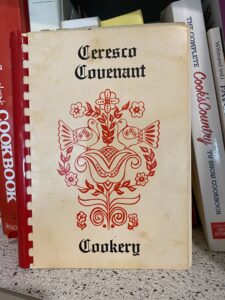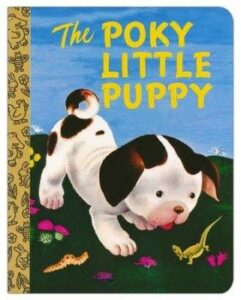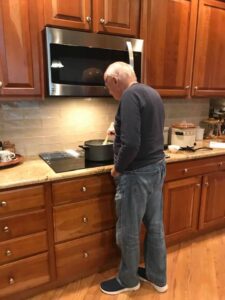This week, our theme is “In the Kitchen.” So many memories revolve around meals and cooking together. Do you have an ancestor who was a good cook (or maybe a notoriously bad cook!) What about a favorite recipe — where did it come from or who always cooked it?
My favorite family recipe is, OF COURSE, Rice Pudding!
First things first. Here is the recipe:
Rice Pudding
1 c. rice
1 c. cold water
½ gallon whole milk
1 c. sugar
1 t. salt
1 egg yolk
1 t. vanilla
1 t. butter
Rinse rice and drain well. Use heavy kettle or double boiler. Add 1 cup water to rice and cook until water is absorbed. Gradually add milk, sugar and salt. Cook over low heat approximately 1 hour or until rice is done, stirring gently to keep from sticking. Gradually stir a portion of the hot mixture into the butter, beaten egg yolk and vanilla. Return this small mixture to kettle and cook 1 minute longer. Remove from heat to cool. Eat warm or chilled.
Important tips:
- I prefer a medium-grained rice, it seems to plump up better than long-grained
- “Rinse rice and drain well” means that you put the rice in your kettle, add tap water, swish around, drain off the water and repeat. Like, a dozen times! You want to do it until the water runs almost clear. You want to get rid of all that excess starch so the rice pudding doesn’t start to thicken up before the rice is fully cooked.
- “Stirring gently to keep from sticking” means that you have to stir the whole time! You’re going to be at the stove for about an hour. Watch out for boiling over – once it gets to a boil, it will try to boil over in a hurry. Be ready to turn the heat down. At right is my dad demonstrating proper stirring technique for a special pandemic treat that he and mom enjoyed a few months ago.
- Once the simmering mixture starts to struggle – like a mud-pot at Yellowstone Park – and making plopping noises and you’re afraid the pan is starting to scorch – you’re ready to scoop out a bit of the mixture to stir in with the egg yolk, butter and vanilla. You want to gradually introduce that egg yolk to the high heat so it doesn’t turn into little bits of scrambled egg. Once you add the egg mixture back in with the rest of the rice pudding, it will still seem kind of soupy but it will thicken up perfectly after cooling down.
- I transfer the hot mixture to a pyrex (or other heat-proof) bowl and cover with plastic wrap, with the plastic wrap actually in contact with the rice mixture. This will prevent liquid from condensing on the bottom side of a lid or worse, on top of the pudding itself. Also, you don’t want a skin to form on the top. Yuck!
- After it’s completely cold, you can give it a good stir and transfer to a prettier serving dish.
- Some people serve rice pudding with raisins or other contaminants. These people are misguided and uninformed. Rice pudding should be served in its pure state. All you need is a bowl and spoon.

We have been enjoying this recipe for as long as I can remember. It is mandatory for our Christmas smörgåsbord each year. It is also a special favorite of my son Kyle, and I make it for his birthday instead of a cake.
Note that while ostkaka is also a contender for a favorite bland Swedish dairy-based dessert, Rice Pudding is the consensus winner in our family.
Our recipe is from the 1963 Ceresco Covenant Church cookbook and was submitted by Anna Swanson. I have a copy of the 1979 edition of the cookbook but sadly, the 1963 edition is not in my collection.
Finally, it’s important to note that rice pudding is featured prominently in the plot of the children’s book “The Poky Little Puppy” which, OF COURSE, was illustrated by a Swedish artist, Gustaf Tenggren.


Lovely!❤️